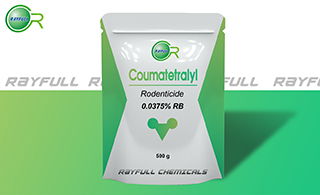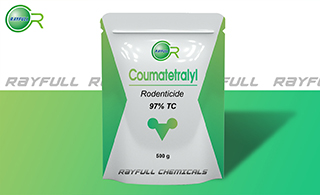COUMATETRALYL

 ЙұКуГС
ЙұКуГС
Introduction: Coumatetralyl is an anticoagulant of the 4-hydroxycoumarin vitamin K antagonist type used as a rodenticide.
Common name: Coumatetralyl
Another name: Endrocid, Endrocide, Racumin, Rodentin, Endox, Cumatetralyl, Coumetralyl, Counmatetralyl, etc.
Chemical name: 4-hydroxy-3-[(1RS)-1,2,3,4-tetrahydro-1-naphthyl]coumarin
Empirical formula: C19H16O3
Structural formula:

Mol. Weight: 292.33 g/mol
CAS No.: 5836-29-3
Specifications
Leading Coumatetralyl supplier
Coumatetralyl 0.0375% RB
Coumatetralyl 0.75% Powder
Coumatetralyl 97% TC
Packing:
BULK PACKING
Liquid: 200L/Drum, 20L/Drum, 10L/Drum ect.
SMALL PACKING
Liquid: 5L/Drum, 1L/Bottle, 500ml/Bottle, 250ml/Bottle, 100ml/Bottle, 50ml/Bottle etc.
Customerized packing label
Professional registration
HAZARDS IDENTIFICATION
Hazard statement(s)
H300: Fatal if swallowed.
H310: Fatal in contact with skin.
H372: Causes damage to organs through prolonged or repeated exposure.
H412: Harmful to aquatic life with long lasting effects.
Precautionary statement(s)
P260: Do not breathe dust/fume/gas/mist/vapors/spray.
P262: Do not get in eyes, on skin, or on clothing.
P264: Wash ... thoroughly after handling.
P270: Do not eat, drink or smoke when using this product.
P273: Avoid release to the environment.
P280: Wear protective gloves/protective clothing/eye protection/face protection.
P301+P310: IF SWALLOWED: Immediately call a POISON CENTER/doctor/...
P302+P350: IF ON SKIN: Gently wash with plenty of soap and water.
P310: Immediately call a POISON CENTER or doctor/physician.
P314: Get medical advice/attention if you feel unwell.
P321: Specific treatment (see ... on this label).
P322: Specific measures (see ...on this label).
P330: Rinse mouth.
P361: Take off immediately all contaminated clothing.
P363: Wash contaminated clothing before reuse.
P405: Store locked up.
P501: Dispose of contents/container to ...
Supplemental Hazard Statements: none
MAMMALIAN TOXICOLOGY
Acute toxicity: 1) Acute oral LD50 for mouse: 16.5 a.i.mg/kg. 2) Acute dermal LD50 for rat: 100 a.i.mg/kg. 3) Inhalation LC50 (4 h) for rat: 0.039 a.i.mg/L. 4) No irritation to eye (rabbits). 5) No Irritation to skin (rabbits). 6) Not a skin sensitiser (guinea pigs).
No component of this product present at levels greater than or equal to 0.1% is identified as probable, possible or confirmed human carcinogen by IARC.
Classification:
Toxicity class WHO (a.i.): Ib (Highly hazardous)
US EPA Classification (formulation): I (Danger - Highly toxic)
EC Risk Classification: T+ - Very toxic: R27/28; T - Toxic: R48/24/25; N - Dangerous for the environment: R52, R53
ECOTOXICOLOGY
Effect on birds: moderate toxicity to birds, acute oral LD50 for Japanese quail is 2000 a.i.mg/kg. Effect on fish: moderate toxicity to fish, acute 96 hour LC50 for Rainbow trout is 48 a.i.mg/L. Effect on aquatic invertebrates: moderate toxicity to aquatic invertebrates, acute 48 hour EC50 for Daphnia magna is 14 a.i.mg/L. Effect on algae: low toxicity to algae, acute 72 hour EC50 is 18 a.i.mg/L.
ENVIRONMENTAL FATE
Although not currently used in the US, coumatetralyl's production and use as a rodenticide may have result in its direct release to the environment. If released to air, a vapor pressure of 6.38ЎБ10-11 mm Hg at 25 deg C indicates coumatetralyl will exist solely in the particulate phase in the atmosphere. Particulate-phase coumatetralyl will be removed from the atmosphere by wet or dry deposition. Coumatetralyl contains chromophores that absorb at wavelengths >290 nm and, therefore, may be susceptible to direct photolysis by sunlight. If released to soil, coumatetralyl is expected to have slight mobility based upon an estimated Koc of 3900. The pKa of coumatetralyl is 4.75, indicating that this compound will partially exist in anion form in the environment and anions generally do not adsorb more strongly to soils containing organic carbon and clay than their neutral counterparts. Volatilization of the neural form from moist soil surfaces is not expected to be an important fate process based upon an estimated Henry's Law constant of 5.8ЎБ10-14 atm-cu m/mole. Volatilization of the anion form from moist soil is not expected because anions do not volatilize. Coumatetralyl is not expected to volatilize from dry soil surfaces based upon its vapor pressure. If released into water, coumatetralyl is expected to adsorb to suspended solids and sediment based upon the estimated Koc. Volatilization from water surfaces is not expected to be an important fate process based upon this compound's estimated Henry's Law constant and pKa. An estimated BCF of 285 suggests the potential for bioconcentration in aquatic organisms is high. Hydrolysis is not expected to be an important environmental fate process based on experimental data. Coumatetralyl was rapidly decomposed in aqueous solutions which were exposed to sunlight or UV with a half-life of about 1 hour, suggesting a potential for direct photolysis.
Usage: Rodenticide commented by G.H. ermann and S.Hombreoher, developed by Bayer AG, patents: DE1079382, US2952689. This material is used as a rodenticide, functioning as an anticoagulant that does not induce bait-shyness.
Application: Coumatetralyl is commonly used with grains and other cereals as a rodent poison in conjunction with a tracking powder to monitor feeding activity in a particular area. Tracking powder also clings to fur, which allows more poison to be ingested from grooming. Concentrations of the chemical are usually 500 mg per 1 kg of bait.
COUMATETRALYL ЙұКуГС
Introduction: Coumatetralyl is an anticoagulant of the 4-hydroxycoumarin vitamin K antagonist type used as a rodenticide.
Common name: Coumatetralyl
Another name: Endrocid, Endrocide, Racumin, Rodentin, Endox, Cumatetralyl, Coumetralyl, Counmatetralyl, etc.
Chemical name: 4-hydroxy-3-[(1RS)-1,2,3,4-tetrahydro-1-naphthyl]coumarin
Empirical formula: C19H16O3
Structural formula:

Mol. Weight: 292.33 g/mol
CAS No.: 5836-29-3
Specifications
Leading Coumatetralyl supplier
Coumatetralyl 0.0375% RB
Coumatetralyl 0.75% Powder
Coumatetralyl 97% TC
Packing:
BULK PACKING
Liquid: 200L/Drum, 20L/Drum, 10L/Drum ect.
SMALL PACKING
Liquid: 5L/Drum, 1L/Bottle, 500ml/Bottle, 250ml/Bottle, 100ml/Bottle, 50ml/Bottle etc.
Customerized packing label
Professional registration
HAZARDS IDENTIFICATION
Hazard statement(s)
H300: Fatal if swallowed.
H310: Fatal in contact with skin.
H372: Causes damage to organs through prolonged or repeated exposure.
H412: Harmful to aquatic life with long lasting effects.
Precautionary statement(s)
P260: Do not breathe dust/fume/gas/mist/vapors/spray.
P262: Do not get in eyes, on skin, or on clothing.
P264: Wash ... thoroughly after handling.
P270: Do not eat, drink or smoke when using this product.
P273: Avoid release to the environment.
P280: Wear protective gloves/protective clothing/eye protection/face protection.
P301+P310: IF SWALLOWED: Immediately call a POISON CENTER/doctor/...
P302+P350: IF ON SKIN: Gently wash with plenty of soap and water.
P310: Immediately call a POISON CENTER or doctor/physician.
P314: Get medical advice/attention if you feel unwell.
P321: Specific treatment (see ... on this label).
P322: Specific measures (see ...on this label).
P330: Rinse mouth.
P361: Take off immediately all contaminated clothing.
P363: Wash contaminated clothing before reuse.
P405: Store locked up.
P501: Dispose of contents/container to ...
Supplemental Hazard Statements: none
MAMMALIAN TOXICOLOGY
Acute toxicity: 1) Acute oral LD50 for mouse: 16.5 a.i.mg/kg. 2) Acute dermal LD50 for rat: 100 a.i.mg/kg. 3) Inhalation LC50 (4 h) for rat: 0.039 a.i.mg/L. 4) No irritation to eye (rabbits). 5) No Irritation to skin (rabbits). 6) Not a skin sensitiser (guinea pigs).
No component of this product present at levels greater than or equal to 0.1% is identified as probable, possible or confirmed human carcinogen by IARC.
Classification:
Toxicity class WHO (a.i.): Ib (Highly hazardous)
US EPA Classification (formulation): I (Danger - Highly toxic)
EC Risk Classification: T+ - Very toxic: R27/28; T - Toxic: R48/24/25; N - Dangerous for the environment: R52, R53
ECOTOXICOLOGY
Effect on birds: moderate toxicity to birds, acute oral LD50 for Japanese quail is 2000 a.i.mg/kg. Effect on fish: moderate toxicity to fish, acute 96 hour LC50 for Rainbow trout is 48 a.i.mg/L. Effect on aquatic invertebrates: moderate toxicity to aquatic invertebrates, acute 48 hour EC50 for Daphnia magna is 14 a.i.mg/L. Effect on algae: low toxicity to algae, acute 72 hour EC50 is 18 a.i.mg/L.
ENVIRONMENTAL FATE
Although not currently used in the US, coumatetralyl's production and use as a rodenticide may have result in its direct release to the environment. If released to air, a vapor pressure of 6.38ЎБ10-11 mm Hg at 25 deg C indicates coumatetralyl will exist solely in the particulate phase in the atmosphere. Particulate-phase coumatetralyl will be removed from the atmosphere by wet or dry deposition. Coumatetralyl contains chromophores that absorb at wavelengths >290 nm and, therefore, may be susceptible to direct photolysis by sunlight. If released to soil, coumatetralyl is expected to have slight mobility based upon an estimated Koc of 3900. The pKa of coumatetralyl is 4.75, indicating that this compound will partially exist in anion form in the environment and anions generally do not adsorb more strongly to soils containing organic carbon and clay than their neutral counterparts. Volatilization of the neural form from moist soil surfaces is not expected to be an important fate process based upon an estimated Henry's Law constant of 5.8ЎБ10-14 atm-cu m/mole. Volatilization of the anion form from moist soil is not expected because anions do not volatilize. Coumatetralyl is not expected to volatilize from dry soil surfaces based upon its vapor pressure. If released into water, coumatetralyl is expected to adsorb to suspended solids and sediment based upon the estimated Koc. Volatilization from water surfaces is not expected to be an important fate process based upon this compound's estimated Henry's Law constant and pKa. An estimated BCF of 285 suggests the potential for bioconcentration in aquatic organisms is high. Hydrolysis is not expected to be an important environmental fate process based on experimental data. Coumatetralyl was rapidly decomposed in aqueous solutions which were exposed to sunlight or UV with a half-life of about 1 hour, suggesting a potential for direct photolysis.
Usage: Rodenticide commented by G.H. ermann and S.Hombreoher, developed by Bayer AG, patents: DE1079382, US2952689. This material is used as a rodenticide, functioning as an anticoagulant that does not induce bait-shyness.
Application: Coumatetralyl is commonly used with grains and other cereals as a rodent poison in conjunction with a tracking powder to monitor feeding activity in a particular area. Tracking powder also clings to fur, which allows more poison to be ingested from grooming. Concentrations of the chemical are usually 500 mg per 1 kg of bait.







